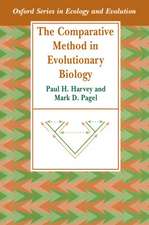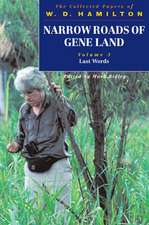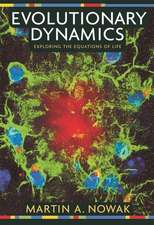Evolutionary Biology and Ecology of Ostracoda: Theme 3 of the 13th International Symposium on Ostracoda (ISO97): Developments in Hydrobiology, cartea 148
Editat de David J. Horne, Koen Martensen Limba Engleză Paperback – 18 dec 2010
| Toate formatele și edițiile | Preț | Express |
|---|---|---|
| Paperback (1) | 789.13 lei 38-44 zile | |
| SPRINGER NETHERLANDS – 18 dec 2010 | 789.13 lei 38-44 zile | |
| Hardback (1) | 953.65 lei 6-8 săpt. | |
| SPRINGER NETHERLANDS – 31 mai 2000 | 953.65 lei 6-8 săpt. |
Din seria Developments in Hydrobiology
- 18%
 Preț: 1229.10 lei
Preț: 1229.10 lei - 18%
 Preț: 959.98 lei
Preț: 959.98 lei - 18%
 Preț: 963.91 lei
Preț: 963.91 lei - 15%
 Preț: 648.24 lei
Preț: 648.24 lei - 15%
 Preț: 637.89 lei
Preț: 637.89 lei -
 Preț: 378.23 lei
Preț: 378.23 lei - 15%
 Preț: 644.95 lei
Preț: 644.95 lei - 18%
 Preț: 952.09 lei
Preț: 952.09 lei - 20%
 Preț: 558.87 lei
Preț: 558.87 lei - 18%
 Preț: 1833.65 lei
Preț: 1833.65 lei -
 Preț: 393.59 lei
Preț: 393.59 lei -
 Preț: 406.54 lei
Preț: 406.54 lei - 18%
 Preț: 1226.73 lei
Preț: 1226.73 lei - 18%
 Preț: 956.99 lei
Preț: 956.99 lei -
 Preț: 388.87 lei
Preț: 388.87 lei - 24%
 Preț: 1060.51 lei
Preț: 1060.51 lei - 18%
 Preț: 1229.28 lei
Preț: 1229.28 lei - 20%
 Preț: 569.30 lei
Preț: 569.30 lei -
 Preț: 368.79 lei
Preț: 368.79 lei - 24%
 Preț: 817.46 lei
Preț: 817.46 lei - 18%
 Preț: 958.25 lei
Preț: 958.25 lei - 18%
 Preț: 953.03 lei
Preț: 953.03 lei -
 Preț: 384.75 lei
Preț: 384.75 lei - 24%
 Preț: 1582.91 lei
Preț: 1582.91 lei - 24%
 Preț: 1051.68 lei
Preț: 1051.68 lei - 18%
 Preț: 943.57 lei
Preț: 943.57 lei - 18%
 Preț: 1235.76 lei
Preț: 1235.76 lei - 24%
 Preț: 800.02 lei
Preț: 800.02 lei - 24%
 Preț: 803.55 lei
Preț: 803.55 lei - 18%
 Preț: 948.29 lei
Preț: 948.29 lei
Preț: 789.13 lei
Preț vechi: 1038.32 lei
-24% Nou
Puncte Express: 1184
Preț estimativ în valută:
151.02€ • 156.01$ • 125.69£
151.02€ • 156.01$ • 125.69£
Carte tipărită la comandă
Livrare economică 21-27 martie
Preluare comenzi: 021 569.72.76
Specificații
ISBN-13: 9789048154999
ISBN-10: 9048154995
Pagini: 212
Ilustrații: XI, 197 p.
Dimensiuni: 210 x 279 x 11 mm
Ediția:Softcover reprint of hardcover 1st ed. 2000
Editura: SPRINGER NETHERLANDS
Colecția Springer
Seria Developments in Hydrobiology
Locul publicării:Dordrecht, Netherlands
ISBN-10: 9048154995
Pagini: 212
Ilustrații: XI, 197 p.
Dimensiuni: 210 x 279 x 11 mm
Ediția:Softcover reprint of hardcover 1st ed. 2000
Editura: SPRINGER NETHERLANDS
Colecția Springer
Seria Developments in Hydrobiology
Locul publicării:Dordrecht, Netherlands
Public țintă
ResearchCuprins
Preface. Ostracoda and the four pillars of evolutionary wisdom; K. Martens, D.J. Horne. Keynote Paper. Open questions in evolutionary ecology: do ostracods have the answers? R.K. Butlin, P. Menozzi. Part 1: Morphological Evolution. Trunk segmentation of some podocopine lineages in Ostracoda; A. Tsukagoshi, A.R. Parker. The ontogeny of the cypridid ostracod Eucypris virens (Jurine, 1820) (Crustacea, Ostracoda); R.J. Smith, K. Martens. Ontogenetic changes in the carapace shape of the non-marine ostracod Eucypris virens (Jurine); A. Baltanás, et al. Multifunctions of the upper lip and a ventral reflecting organ in a bioluminescent ostracod Vargula hilgendorfii (Müller, 1890); K. Abe, et al. Factors affecting the divergence of mate recognition systems in the Limnocytherinae (Crustacea, Ostracoda); K. Martens. Part 2: Evolutionary History - the Fossil Record. An example of intralacustrine evolution at an early stage: the freshwater ostracods of the Miocene crater lake of Steinheim (Germany); H. Janz. The origins of modern nonmarine ostracod faunas: evidence from the Late Cretaceous and Early Palaeogene of Mongolia; K. Yo. The evolutionary history of Late Permian Darwinulocopina Sohn, 1988 (Ostracoda) from the Russian Plate; I.I. Molostovskaya. Part 3: Ecology and Palaeoecology. Variable noding in Cyprideis torosa (Ostracoda, Crustacea): an overview, experimental results and a model from Catastrophe Theory; D. van Harten. The effect of temperature on shell size and growth rate in Krithe praetexta praetexta (Sars); S. Majoran, et al. The life history and culturing of Xestoleberis hanaii (Crustacea, Ostracoda); N. Ikeya, M. Kato. Factors Influencingintraspecific variation and polymorphism in marine podocopid Ostracoda, with particular reference toTertiary species from southeastern Australia; J.V. Neil. Trend, signal and noise in the ecology of Ostracoda: information from rare species in low-diversity assemblages; J.M. Slack, et al. Reproductive strategy of an isopod Onisocryptus ovalis, parasitizing a bioluminescent myodocope ostracod Vargula hilgendorfii; K. Abe, J. Horiuchi.
















